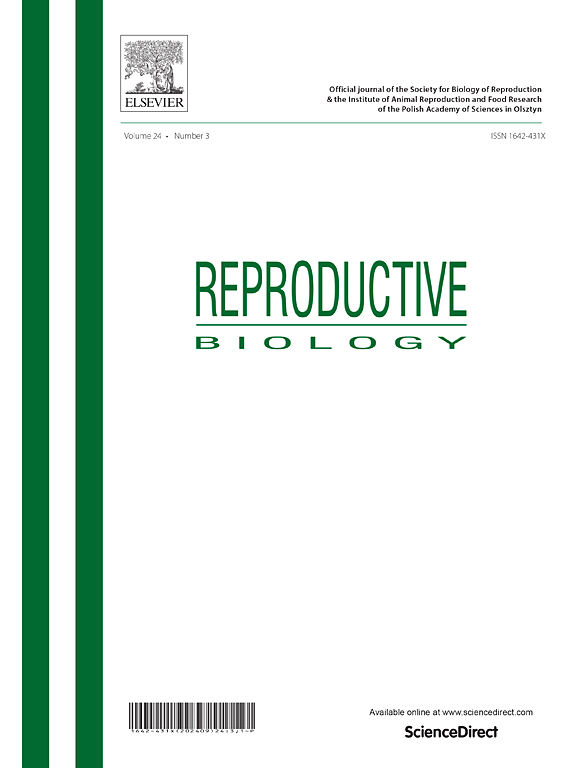Toxicological effects of fluazuron on bovine reproductive cells: Implications for fertilization, sperm quality, and oviductal integrity
IF 2.5
3区 生物学
Q3 REPRODUCTIVE BIOLOGY
引用次数: 0
Abstract
Fluazuron is a veterinary antiparasitic compound widely used as pour-on in cattle. However, little is known about its potential reproductive toxicity. This study aimed to evaluate the effects of fluazuron on sperm quality, bovine oviduct epithelial cells (BOECs), and bovine in vitro fertilization (IVF). Frozen-thawed sperm were exposed to fluazuron (50 µg/mL) for 2 h and evaluated for motility, mitochondrial activity, and membrane integrity, while BOECs were cultured with fluazuron for 24 h and assessed using MTT and comet assays. IVF was performed with gametes exposed to fluazuron for 18 h to evaluate pronuclear formation, and 24 h to study embryo development. Short-term fluazuron did not significantly affect sperm motility, viability, or membrane function. However, it decreased viability and induced DNA damage in BOECs after 24 h of treatment. Following fluazuron exposure during IVF, no differences were observed between the fluazuron-treated group and the control group in terms of pronuclear formation. However, a significantly higher incidence of abnormally condensed chromatin within the pronuclei was detected in the fluazuron-treated group. Furthermore, embryonic development decreased in both blastocyst and hatching rates in fluazuron treatment. These findings suggest that fluazuron may disrupt early reproductive events through multiple mechanisms, including BOEC dysfunction and chromatin damage. Our results highlight the importance of evaluating reproductive risks associated with antiparasitic drug exposure in livestock.
氟唑龙对牛生殖细胞的毒理学影响:对受精、精子质量和输卵管完整性的影响
氟唑脲是一种兽药抗寄生虫化合物,广泛用于牛的倾倒。然而,人们对其潜在的生殖毒性知之甚少。本研究旨在评价氟唑龙对精子质量、牛输卵管上皮细胞(BOECs)和牛体外受精(IVF)的影响。将冷冻解冻的精子暴露在氟祖龙(50 µg/mL)中2 小时,并评估其活力、线粒体活性和膜完整性,而boec用氟祖龙培养24 小时,并使用MTT和comet测定法评估。将配子暴露在fluazuron中18 h以评估原核形成,24 h以研究胚胎发育。短期氟唑龙对精子活力、活力或膜功能没有显著影响。然而,在24 h后,它降低了BOECs的活力并诱导DNA损伤。在试管婴儿期间暴露于氟唑龙后,氟唑龙治疗组和对照组在原核形成方面没有观察到差异。然而,在氟唑龙处理组中,检测到原核内异常浓缩染色质的发生率明显更高。此外,在氟唑龙处理下,囊胚发育和孵化率均下降。这些发现表明氟唑龙可能通过多种机制破坏早期生殖事件,包括BOEC功能障碍和染色质损伤。我们的研究结果强调了评估与家畜抗寄生虫药物暴露相关的生殖风险的重要性。
本文章由计算机程序翻译,如有差异,请以英文原文为准。
求助全文
约1分钟内获得全文
求助全文
来源期刊

Reproductive biology
生物-生殖生物学
CiteScore
3.90
自引率
0.00%
发文量
95
审稿时长
29 days
期刊介绍:
An official journal of the Society for Biology of Reproduction and the Institute of Animal Reproduction and Food Research of Polish Academy of Sciences in Olsztyn, Poland.
Reproductive Biology is an international, peer-reviewed journal covering all aspects of reproduction in vertebrates. The journal invites original research papers, short communications, review articles and commentaries dealing with reproductive physiology, endocrinology, immunology, molecular and cellular biology, receptor studies, animal breeding as well as andrology, embryology, infertility, assisted reproduction and contraception. Papers from both basic and clinical research will be considered.
 求助内容:
求助内容: 应助结果提醒方式:
应助结果提醒方式:


